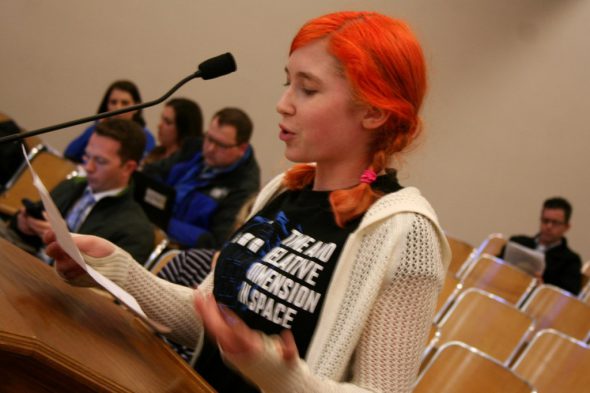MPS School Uniform Policy Faces Criticism
Won’t achieve its goals, critics say. Parents divided, survey found.

Freda Fowlkes-Bell, a longtime teacher at Washington High School, speaks in support of the uniform policy at a public hearing. Photo by Jabril Faraj.
Critics of a new MPS policy requiring students to wear uniforms beginning next fall say it will not accomplish its goals to contribute to a positive school environment by minimizing bullying and lowering costs for low-income families.
“Bullying isn’t caused by what outfits people wear. Bullies target people because they want to make themselves feel good,” said Ava Antonie, 11, a student at Burdick Elementary School who previously attended private school and wore a uniform until 2nd grade. “Outfits won’t change anything — bullies will just find new ways to bully people.”
The Milwaukee Public Schools (MPS) Board of Directors passed a districtwide uniform policy Feb. 23. The move was hotly contested at a board meeting where parents, students and a former teacher testified against the proposed change.
Larry Hoffman, an education activist and member of Schools & Communities United, said uniforms will only “cover over” the problem. “Whether there’s going to be uniforms in a school or not, you have to talk about differences among people and how we deal with differences among people,” he said.
Three MPS principals testified in favor of the policy.
The policy, which is not mandatory, reverses current policy, said board member Carol Voss during testimony at the recent meeting. Previously, a school governance council could implement a dress code or uniform requirement, but only because of “a specific educational, health, or safety purpose.” A change at a particular school could only happen in the case of “broad-based support” from students, teachers and parents. Any modification, or rescinding, of an existing uniform policy required a petition signed by 20 percent of the school community.

Ava Gessner, a student at Golda Meir, speaks against the uniform policy during a recent board meeting. Photo by Jabril Faraj.
Fifty-one of the district’s more than 150 schools already have a dress code or require uniforms.
Beginning in fall 2017, every school in the district must comply with the policy unless 66 percent of the school community opposes it. The school must then send a written letter to the Regional Superintendent stating the reasons for its decision. Matthew Boswell, head of the MPS Department of Student Services, said if a school achieved the required two-thirds agreement to opt out the request would be honored.
Parents also have the ability to opt out by signing and filing an exemption form with the school’s principal.
School Board President Mark Sain said the move was made in an attempt to meet the needs of MPS families. He added that he hoped it would help create a better atmosphere for learning and noted that the pros outweigh the cons.
“The uniform policy is not a silver bullet,” Sain said. “I don’t look at this as being a one-stop-shop of stopping bullying … But I think, in some schools, it’s going to help.”
A survey conducted between Nov. 2 and Dec. 2 of last year received 11,762 responses from parents. Of the respondents, 41 percent were in favor of uniforms, 38 percent were opposed and 15 percent had no preference. About 77,000 students were enrolled in 2016-17.
Both opponents and those in favor of uniforms questioned why the policy is not mandatory. Two students who spoke on different sides of the issue at the board meeting expressed concern that giving individual families the ability to opt out would create a clear division within schools between those who are exempt and those who are not.
“I don’t think it’s effective if it’s not something that everybody’s doing,” said Patricia Hoben, head of schools at Carmen Schools of Science and Technology, a high-performing MPS charter network that requires uniforms at each one of its three campuses. “If somebody signs up for a school and that school’s opted in for uniforms, then I think that school’s expectation should be that everybody will wear uniforms and that that school will do everything possible to make it possible for every family to participate.”
MPS will allocate $1.3 million to schools to help mitigate the cost of uniforms. Many of those who testified said that amount, about $17 per student, would not significantly help struggling families. Eighty percent of MPS students are considered economically disadvantaged.
This story was originally published by Milwaukee Neighborhood News Service, where you can find other stories reporting on fifteen city neighborhoods in Milwaukee.





















One thing lacking in this story… is any reasoning behind why people oppose the uniforms, other than that it won’t by itself stop bullying.
The cost. I know that concern has been expressed by some. Some research suggests uniforms don’t improve academic performance. The way young people feel like clothes is how they express themselves. That may seem trite to adults but it’s a big deal for young people.
AG, is that one reason not good enough for you? Perhaps you see other benefits that outweigh that negative such that you discount its existence and ask for more?
Why spend the money on it (collectively, as assistance, and presumably taking away from something else) or force people to spend money (even if assisted, out-of-pocket is non-zero) on it if it isn’t going to solve a problem?
If it isn’t effective at addressing bullying, then it should’ve never been sold as an attempt to do that. Shame on MPS for misleading the public in that direction, either directly or indirectly.
@AG That’s not really how policy debate works.
Vincent, from everything I’ve seen, peer reviewed studies show multiple benefits. They ranged from a decrease in violence to ability of students to worry less about clothing choices so they can concentrate more on their studies.
I’ve seen many arguments in favor and few valid ones against. Cost is valid, but the benefits outweigh those to me.
I don’t understand the problem with uniforms. It makes life much more fair for kids who can’t afford fancy clothes. Clothes are not a way to “express yourself”, they’re a costly distraction from school.
Oh so you weren’t really looking for reasons against AG. You already had your mind made up. Also, feel free to cite some peer reviewed studies showing benefits. I’ll share what I found.
“Despite the media coverage,” Brunsma writes in The School Uniform Movement and What It Tells Us About American Education, “despite the anecdotal meanderings of politicians, community members, educators, board members, parents, and students, uniforms have not been effective at attacking the very outcomes and issues they were assumed to aid.” Brunsma is David Brunsma, a researcher at the University of Missouri-Columbia. Brunsma, an assistant professor of sociology, has been studying the movement for public school uniforms since 1996.
The Guardian has covered the issue and written several stories that show they haven’t helped in the UK. A Freakonomics story cites a University of Houston study that shows uniforms improve attendance but not academic outcomes. The National Center for Education Statistics analyzed primary and secondary school data over a period of 16 years and found no evidence of improvement in grades.
I’ll let this iron itself out but I will point out a HUGE flaw in the survey that was asked to be filled out. I took the survey and since I have a background in Marketing decided to see what happened if I clicked the link again. POOF right back to the start of the survey so I could completely fill it out again thus could push the odd in favor of one choice or the other.
I alerted MPS to this and received a “Thanks” but nothing was said as to if it would be fixed.
Why not uniforms? Ask those teachers and adults standing at the podium espousing uniforms for students. They should be wearing their uniform and who knows, maybe it will catch on. After all, a teacher’s biggest job is modeling good behavior and attitudes for students. Try those uniforms out, teachers and parents. See how they feel. Do you feel more inclined or less inclined to bully? Is your school spirit stronger? Do those uniforms make you a better teacher or parent or are there perhaps some niggling changes in your thinking that make you just a bit uncomfortable.
School uniforms are another tactic of Bannon/DeVos type of nationalism that we must all subscribe to the same creeds and party to be ‘stronger’. School uniforms are popular in places like China and in southern statehouses. Serious proponents of uniforms wish to squash the opportunity of free thought or expression under whatever false claims of “good” they can peddle. And if it pushes a few freethinkers and non-conformists, or those that are not white and right, out of the schools – well, they see that as a plus. This is a dangerous trend that will only divide those students from each other. It is a backlash against those who see value in diversity. Once those kids are used to wearing a uniform it will be so much easier to keep them in uniforms and in line as adults.
I like the idea of uniforms and even though I might not have felt that way when I was in middle school it sure would have saved my grandma from having to buy me a dum pair of tommy hilfugure jeans that cost $100 and only ingrained the worst part about living in America to me and everyone that saw me in those. That you need to spend money to be happy and for people to think your cool….
How can we expect children to learn how to dress themselves when the big wig picks their outfit for them?
Also… let’s face it, uniforms mean stinky kids.
ALSO, if my uniform is gross and I cannot manage or afford to get it cleaned, then I may as well not go to school.
Uniforms create problems.
Also… reading that 51 schools in MPS have uniforms already… comments like that should be cautioned. MPS prides itself in diversity. If the district creates policies that are consistent among all schools, it risks hegemonizing them.
Ben T., actually 51 MPS schools “have a dress code or require uniforms.” Those are two very different policies.
My Catholic elementary school had a dress code and I wore uniforms in high school. We did everything possible to “accessorize” our uniforms to express individuality.
I’m not opposed in theory but I’ve heard school staff confirm Ben’s point about students not attending if their uniforms are not wearable.
Then there’s the issue of cost. Many low- and middle income families buy second-hand clothing or do hand-me-downs among family and friends (as our family did). It seems possible that buying new uniforms will cost more. As Vincent notes, the school board may not have thought this out very well or considered solid research.
If there was evidence it really worked I’d be far more enthusiastic. And 66% opposition seems a high bar for opting out.